Options for Pre-treating Water in Chlorination Projects
Introduction
Sodium hypochlorite solution (chlorine) is effective at treating both clear and turbid (dirty-looking) water. Because of the additional chlorine demand in turbid water, users are instructed to double the dosage of chlorine (adding 2 capfuls of solution instead of 1 capful, for a dosage of 3.8 mg/L as opposed to 1.9 mg/L) in order to effectively disinfect turbid water and maintain free chlorine levels during storage.
However, many users prefer water treatment processes that visually improve the look of the water. Although the following options are not proven to reduce diarrheal disease incidence on their own, they can be used to pre-treat water before chlorination to remove unsightly particles that may have absorbed pathogens, as well. In addition, in some cases, these pre-treatment mechanisms may increase the efficacy of the sodium hypochlorite solution in treating turbid waters.
Options
Six locally-available, inexpensive options to pre-treat water before chlorination are described in the following sections. This is not a complete list of all options, as there are other natural flocculants and local materials used worldwide.
- Filtration through a cloth 1, 2
- Filtration through sand 2
- Settling and decanting 2
- Moringa seed flocculation 3
- Raket flocculation
- Alum flocculation 3
This document should prove useful to you as you consider pre-treatment options to improve water clarity and acceptance of water treatment with sodium hypochlorite by the target population.

Filtering water through a cloth.
Filtration through a cloth
A simple pre-treatment option is to filter water through a locally available cloth. Users simply pour water from the transport container through the cloth into another transport or storage container. Benefits of this option include its simplicity, the wide availability of cloth, and the fact that filtration through multiple layers of sari cloth was proven to reduce cholera transmission in Bangladesh 2. Drawbacks of this option are that it requires two containers and the filtration capacity of cloth varies greatly, and filtering through multiple layers of cloth can be very slow. In laboratory studies, the use of cloth filtration did slightly reduce the turbidity of water, but did not reduce the chlorine demand of water. Thus, it is still recommended to add the double dose of sodium hypochlorite solution after filtration through a cloth.
Filtration through Sand
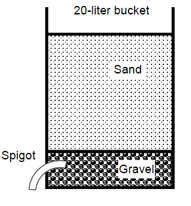
20-liter bucket with spigot.
Filtration through sand is a fast and simple pretreatment option. Users pour water from one transport container through a container of sand with gravel and an opening or spigot at the bottom. The water then flows into a storage container. The benefits of sand filtration are that it is effective at removing some bacteria, it is simple and fast for the user, and is inexpensive if sand is available locally. The drawback of sand filtration is that it requires three containers and a spigot. In laboratory studies, the use of sand filtration significantly reduced the turbidity of water, and also significantly reduced the chlorine demand of turbid waters 2. Thus, it is recommended to add only a single dose of sodium hypochlorite solution after filtration through sand.
Settling and Decanting (Pouring)
Settling and decanting (pouring) is a way to reduce the turbidity of water by letting the water sit for 2-24 hours so that the particulates settle to the bottom of the container. The clear water is then poured off the top into a second container being careful not to disturb the material settled at the bottom. The benefit of settling and decanting is that it requires no equipment besides the buckets. The drawbacks of settling and decanting are the need for two containers, the time it takes the water to settle, and the fact it is difficult to observe the effects or decanting in opaque storage containers. In laboratory studies, the use of settling and decanting significantly reduced the turbidity of water, and also significantly reduced the chlorine demand of turbid waters 2. Thus, it is recommended to add only a single dose of sodium hypochlorite solution after settling and decanting.
| The turbid water. | After settling. | Decanting. | Clear water. |
|---|---|---|---|
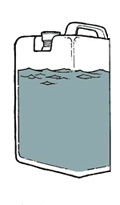
|
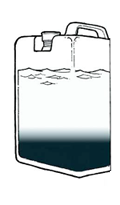
|
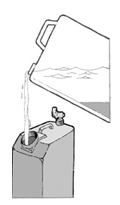
|
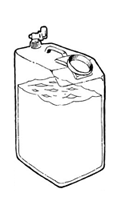
|
Moringa Seed Flocculation
The moringa tree pod contains a seed which, when crushed, is a natural flocculant (facilitates particles sticking together so they settle out of solution or filter more easily). Users pick and dry the pods, and then remove the seeds. The seeds are shelled, crushed using a mortar and pestle, and then about 2 grams of the seeds are added to 20 liters of water. The water is stirred for five minutes, and users let the moringa settle for 24 hours before decanting the clear water off into another container. The benefits of moringa are that it is an effective flocculant. The drawbacks of the use of moringa as a pretreatment option are that it is a time and labor-intensive process, the dosing of moringa is unclear for users, the moringa flavor to the water may be objectionable, and it increases chlorine demand to the point where adequate free chlorine residual is not maintained for 24 hours after treatment 3.
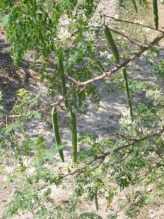
Moringa tree with pods.
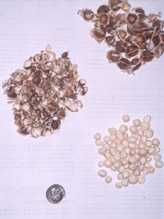
Seeds with shells (top right) shells (middle), seeds (bottom right)
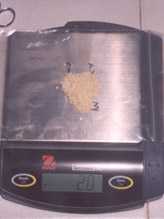
2 grams of crushed seeds
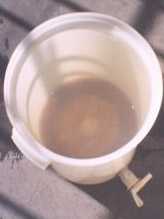
Water treated with crushed moringa seeds that had
settled for 24 hours and is ready to decant.
Raket Flocculation
In Haiti, the cactus raket contains a natural flocculant. Users pick the raket, cut it diagonally to expose the maximum flesh surface area, add the raket to the water, stir briefly, wait ten minutes, and then strain the water through a cloth. The benefits of raket are that it is very effective at removing turbidity, and the raket is widely available and easy to prepare. The drawback of raket is the more complex two-step procedure for the user of raket preparation and addition, followed by cloth filtration. It is unknown if the use of raket reduces chlorine demand.
Alum Flocculation
Aluminum sulfate is widely used as a flocculant in water treatment plants in the United States. It is also widely available in developing countries, sold in blocks of soft white stone, and generally called alum. There are numerous ways to use alum as a flocculant, including to crush it into a powder before adding it to water, stirring and decanting or stirring the whole stone in the water for a few seconds and waiting for the solids to settle. The benefits of alum are that it is widely available, is proven to reduce turbidity, and is inexpensive. The drawback of alum is that the necessary dosage varies unpredictably. Laboratory studies have shown that alum is effective at reducing turbidity and chlorine demand 3.
References
- Huq A, Yunus M, Sohel SS, Bhuiya A, Emch M, Luby SP, Russek-Cohen E, Nair GB, Sack RB, Colwell RR. Simple sari cloth filtration of water is sustainable and continues to protect villagers from Cholera in Matlab, Bangladesh. mBio. 2010;May 1(1):e00034-10.
- Kotlarz N, Lantagne D, Preston K, Jellison K. Turbidity and chlorine demand reduction using locally available physical water clarification mechanisms before household chlorination in developing countries. J Water Health. 2009;7(3):497-506.
- Preston K, Lantagne D, Kotlarz N, Jellison K. Turbidity and chlorine demand reduction using alum and moringa flocculation before household chlorination in developing countries. Water Health. 2010;8(1):60-70.
- Page last reviewed: April 16, 2014
- Page last updated: April 16, 2014
- Content Source:


 ShareCompartir
ShareCompartir